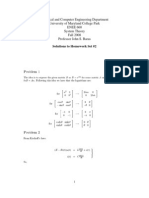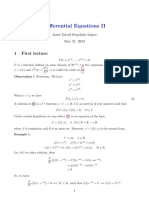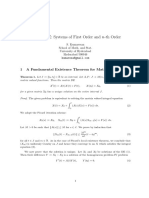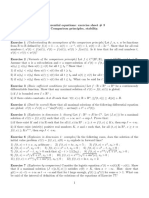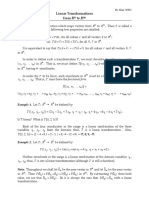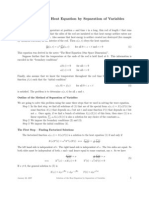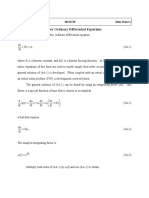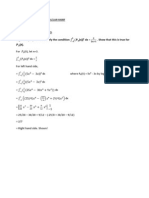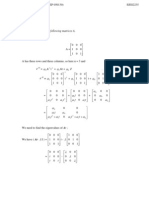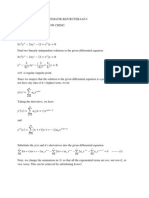Professional Documents
Culture Documents
Name: Syazwani Bt. Ismail Matric. No: SES060689
Name: Syazwani Bt. Ismail Matric. No: SES060689
Uploaded by
api-3861295Original Description:
Original Title
Copyright
Available Formats
Share this document
Did you find this document useful?
Is this content inappropriate?
Report this DocumentCopyright:
Available Formats
Name: Syazwani Bt. Ismail Matric. No: SES060689
Name: Syazwani Bt. Ismail Matric. No: SES060689
Uploaded by
api-3861295Copyright:
Available Formats
Name : Syazwani bt.
Ismail
Matric. No : SES060689
Question 26.9
Solve the following system by matric method.
.. .
x+ 2x - 8x = 0 ; x(1) = 1, x(1) = 0
Solution
.. .
We write x = - 2x + 8x = 0 , hence a₁(t ) = -2 , aₒ(t ) = 8 and f(t ) = 0
.
Define that x1(t ) = x and x2(t ) = x , we obtain
.
x1 = x2 , we find
. .
x2 = d2x = -2x + 8x = -2x2 + 8x1
dt2
.
thus x1 = 0x1 + 1x2
.
x2 = 8x1 - 2x2
.
These equation are equivalent to the matrix equation x(t ) = A(t )x(t ) + f(t )
If we define,
x(t )≡ x1(t ) , A(t ) ≡ 0 1 and f(t ) ≡ 0
x2(t ) 8 -2 0
The differential equation is then equivalent to the matrix equation
. .
x(t) = A(t )x(t ) + f(t ), or simply x(t) = A(t )x(t ), since f(t) = 0. The initial conditions can
be given by x(to) = c , if we
define to = 1 and c = 1
Since we n=2, then
eAt = α1At + α0I = α0 α1t
8α1t -2 α1t + α0
and r(ʎ )= α₁ʎ + αo. The eigenvalues of At are ʎ 1 = 2t and ʎ 2 = -4t .
Then,
e2t = α₁(2t) + αo
e-4t = α₁(-4t) + αo
solve the α₁ and αo , we find that
α₁ =1/6 (e2t – e-4t) and αo = 1/3(2e2t + e-4t) so,
eAt = 1 4e2t + 2e-4t e2t – e-4t
6 8e2t – 8e-4t 2e2t + 4e-4t
Since the initial value problem is homogeneous, f(t)=0 then the solution is
x(t) = eA(t-t0)c
= 1 4e2(t-1) + 2e-4(t-1) e2(t-1) – e-4(t-1) 1
6 8e2(t-1) – 8e-4(t-1) 2e2(t-1) + 4e-4(t-1) 0
= 1 4e2(t-1) + 2e-4(t-1) + 0
6 8e2(t-1) – 8e-4(t-1) + 0
And the solution to the original initial value problem is
x(t) = x1(t) = 2/3 e2(t-1) + 1/3 e-4(t-1)
You might also like
- ENEE 660 HW Sol #2Document9 pagesENEE 660 HW Sol #2PeacefulLionNo ratings yet
- HMWK 2Document3 pagesHMWK 2Eren Can KızıldağNo ratings yet
- Fundamental Matrix Solution.Document9 pagesFundamental Matrix Solution.MeaziyeNo ratings yet
- Differential Equations 2020/21 MA 209: Lecture Notes - Section 1.1Document4 pagesDifferential Equations 2020/21 MA 209: Lecture Notes - Section 1.1SwaggyVBros MNo ratings yet
- Math 677. Fall 2009. Homework #3 SolutionsDocument3 pagesMath 677. Fall 2009. Homework #3 SolutionsRodrigo KostaNo ratings yet
- HW 5Document4 pagesHW 5pt422No ratings yet
- Name: Siti Zaharah Binti Sulehin Matrix. No: SES060662Document3 pagesName: Siti Zaharah Binti Sulehin Matrix. No: SES060662api-3861295No ratings yet
- Systems of First Order Differential Equations: Department of Mathematics IIT Guwahati Shb/SuDocument16 pagesSystems of First Order Differential Equations: Department of Mathematics IIT Guwahati Shb/SuakshayNo ratings yet
- MATH 304 Linear Algebra Matrix ExponentialsDocument13 pagesMATH 304 Linear Algebra Matrix ExponentialsDenis SaricNo ratings yet
- Chapter 6Document48 pagesChapter 6Cristian LopezNo ratings yet
- ODEs II CompletoDocument11 pagesODEs II CompletoJosué David Regalado LópezNo ratings yet
- Linear ODESDocument12 pagesLinear ODESAdi SubbuNo ratings yet
- Taylor Expansions in 2dDocument5 pagesTaylor Expansions in 2dpazrieNo ratings yet
- Systems of First Order Differential Equations: Department of Mathematics IIT GuwahatiDocument18 pagesSystems of First Order Differential Equations: Department of Mathematics IIT GuwahatiAwais Mehmood BhattiNo ratings yet
- Enae 641Document6 pagesEnae 641bob3173No ratings yet
- Week 121Document15 pagesWeek 121situvnnNo ratings yet
- Answers To Final-2021Document9 pagesAnswers To Final-2021Enes ErtenNo ratings yet
- Differentialequations EC400 MT2013 PDFDocument20 pagesDifferentialequations EC400 MT2013 PDFAvijit PuriNo ratings yet
- 427K M2 SolutionsDocument3 pages427K M2 SolutionsBrian TeaNo ratings yet
- Math 462: HW3 SolutionsDocument8 pagesMath 462: HW3 SolutionssCoRPion_trNo ratings yet
- Tutorial 8 So LnsDocument3 pagesTutorial 8 So Lnspankaj100% (1)
- Systems of Linear Equations: 1 Matrix FunctionsDocument12 pagesSystems of Linear Equations: 1 Matrix FunctionsSeow Khaiwen KhaiwenNo ratings yet
- Signals & Systems B38SA 2018: Chapter 2 Assignment Question 1 - Theory - 10 MarksDocument6 pagesSignals & Systems B38SA 2018: Chapter 2 Assignment Question 1 - Theory - 10 MarksBokai ZhouNo ratings yet
- HW1 SolutionDocument3 pagesHW1 SolutionZim ShahNo ratings yet
- Exercise Sheet-3Document2 pagesExercise Sheet-3pauline chauveauNo ratings yet
- Mean Value Formula Heat Equation PDFDocument6 pagesMean Value Formula Heat Equation PDFAlessandra NegriniNo ratings yet
- Module3-Signals and SystemsDocument28 pagesModule3-Signals and SystemsAkul PaiNo ratings yet
- Dr. Alexander Schaum Chair of Automatic Control, Christian-Albrechts-University KielDocument4 pagesDr. Alexander Schaum Chair of Automatic Control, Christian-Albrechts-University KielkevweNo ratings yet
- 2019 Answers PDFDocument56 pages2019 Answers PDFNitya Pooja ReddyNo ratings yet
- Solution Guide, Differential EquationDocument53 pagesSolution Guide, Differential EquationhmbxNo ratings yet
- Optimal Control (Course Code: 191561620)Document4 pagesOptimal Control (Course Code: 191561620)Abdesselem BoulkrouneNo ratings yet
- Nbody DissipativeDocument44 pagesNbody DissipativeFulana SchlemihlNo ratings yet
- A Class of Third Order Parabolic Equations With Integral ConditionsDocument7 pagesA Class of Third Order Parabolic Equations With Integral ConditionsArmin SuljićNo ratings yet
- Matsysbok - Ps PagesDocument5 pagesMatsysbok - Ps PagesMouliNo ratings yet
- Chap 5 P2.2Document40 pagesChap 5 P2.2hlthanhthao1305No ratings yet
- Lesson 5: First Order Linear Differential Equations: William Mccallum 6 September 2005Document4 pagesLesson 5: First Order Linear Differential Equations: William Mccallum 6 September 2005RaymondNo ratings yet
- ch2 2019Document40 pagesch2 2019Ny Sata AndrianirinaNo ratings yet
- Solution of State Space EquationDocument11 pagesSolution of State Space EquationAnirban MitraNo ratings yet
- Fall 2013 Math 647 Homework 5Document9 pagesFall 2013 Math 647 Homework 5gsmarasigan08No ratings yet
- Dnyanopasak Shikshan Mandal'Scollege of Art'S Commerce and Science Synopsis Academic Year 2018-19Document7 pagesDnyanopasak Shikshan Mandal'Scollege of Art'S Commerce and Science Synopsis Academic Year 2018-19Arbaz KhanNo ratings yet
- MA 102 (Ordinary Differential Equations)Document1 pageMA 102 (Ordinary Differential Equations)SHUBHAMNo ratings yet
- Linear Transformation 1 PDFDocument14 pagesLinear Transformation 1 PDFpanbuuNo ratings yet
- sns 2021 중간 (온라인)Document2 pagessns 2021 중간 (온라인)juyeons0204No ratings yet
- Tutorial 8: SC-116 Algebraic Structures Autumn 2015 (Linear Transformations)Document1 pageTutorial 8: SC-116 Algebraic Structures Autumn 2015 (Linear Transformations)pankajNo ratings yet
- Solving The Heat Equation by Separation of VariablesDocument4 pagesSolving The Heat Equation by Separation of VariablesJasper CookNo ratings yet
- Linear Equations: y R × N. Recall, For Instance, That We Can Always Rewrite An NTH + ADocument56 pagesLinear Equations: y R × N. Recall, For Instance, That We Can Always Rewrite An NTH + ASteven Robert TsengNo ratings yet
- Teschl ErrataDocument10 pagesTeschl ErratasandorNo ratings yet
- Linfirst PDFDocument2 pagesLinfirst PDFEarl averzosaNo ratings yet
- Solutions Even ExercisesDocument28 pagesSolutions Even ExercisesKarl SchmidtNo ratings yet
- Math 202 PS6 SolutionsDocument8 pagesMath 202 PS6 SolutionsasdasdasdNo ratings yet
- Answer 2016Document8 pagesAnswer 2016John ChanNo ratings yet
- Linear Systems With Control TheoryDocument157 pagesLinear Systems With Control Theoryrangarazan100% (2)
- Ma 266 ReviewDocument9 pagesMa 266 ReviewiiiiiiiNo ratings yet
- Math 677. Fall 2009. Homework #4 SolutionsDocument3 pagesMath 677. Fall 2009. Homework #4 SolutionsRodrigo KostaNo ratings yet
- A Homework On Solid Mechanics: Problem 1: Determinant Identity Q.1aDocument5 pagesA Homework On Solid Mechanics: Problem 1: Determinant Identity Q.1aAmritaNo ratings yet
- The Zero-State Response Sums of InputsDocument4 pagesThe Zero-State Response Sums of Inputsbaruaeee100% (1)
- A Homework On Engineering Analysis: Problem 1: First Order Odes Q.1ADocument5 pagesA Homework On Engineering Analysis: Problem 1: First Order Odes Q.1AAmritaNo ratings yet
- Appendix 4: First-Order Ordinary Differential Equations: EE426/506 Class Notes 06/23/10 John StensbyDocument3 pagesAppendix 4: First-Order Ordinary Differential Equations: EE426/506 Class Notes 06/23/10 John StensbyKiran GopalanNo ratings yet
- Mathematics 1St First Order Linear Differential Equations 2Nd Second Order Linear Differential Equations Laplace Fourier Bessel MathematicsFrom EverandMathematics 1St First Order Linear Differential Equations 2Nd Second Order Linear Differential Equations Laplace Fourier Bessel MathematicsNo ratings yet
- Green's Function Estimates for Lattice Schrödinger Operators and ApplicationsFrom EverandGreen's Function Estimates for Lattice Schrödinger Operators and ApplicationsNo ratings yet
- Qu 2916Document2 pagesQu 2916api-3861295No ratings yet
- Qu 3027Document2 pagesQu 3027api-3861295No ratings yet
- Qu 2745Document2 pagesQu 2745api-3861295No ratings yet
- Qu 2914Document2 pagesQu 2914api-3861295No ratings yet
- Qu 3031Document1 pageQu 3031api-3861295No ratings yet
- Qu 2826Document2 pagesQu 2826api-3861295No ratings yet
- Qu 2915Document1 pageQu 2915api-3861295No ratings yet
- Qu 2747Document3 pagesQu 2747api-3861295No ratings yet
- Qu 2913Document1 pageQu 2913api-3861295No ratings yet
- Qu 3026Document1 pageQu 3026api-3861295No ratings yet
- For The Following Matrices A.: A At+ I .. Equ. (I)Document3 pagesFor The Following Matrices A.: A At+ I .. Equ. (I)api-3861295No ratings yet
- Qu 2917Document1 pageQu 2917api-3861295No ratings yet
- Qu 2832Document2 pagesQu 2832api-3861295No ratings yet
- Qu 2827Document3 pagesQu 2827api-3861295No ratings yet
- Qu 3025Document1 pageQu 3025api-3861295No ratings yet
- Qu 2615Document2 pagesQu 2615api-3861295No ratings yet
- Qu 2825Document3 pagesQu 2825api-3861295No ratings yet
- Qu 2614Document3 pagesQu 2614api-3861295No ratings yet
